Excerpts from Jim Conrad's
Naturalist Newsletter
from the June 4, 2017 Newsletter issued from Rancho Regenesis in the woods ±4kms west of Ek Balam Ruins; elevation ~40m (~130 ft), N20.876°, W88.170°; north-central Yucatán, MÉXICO
BALSAM APPLE
The other day an old rancher and friend of ours from up the road at Temozón, Don Solís, brought us several bushels of amazing fruits for feeding to the ranch's livestock. Below, you can see some in my hand, one broken open to reveal bright-red, slimy, bean-like seeds:
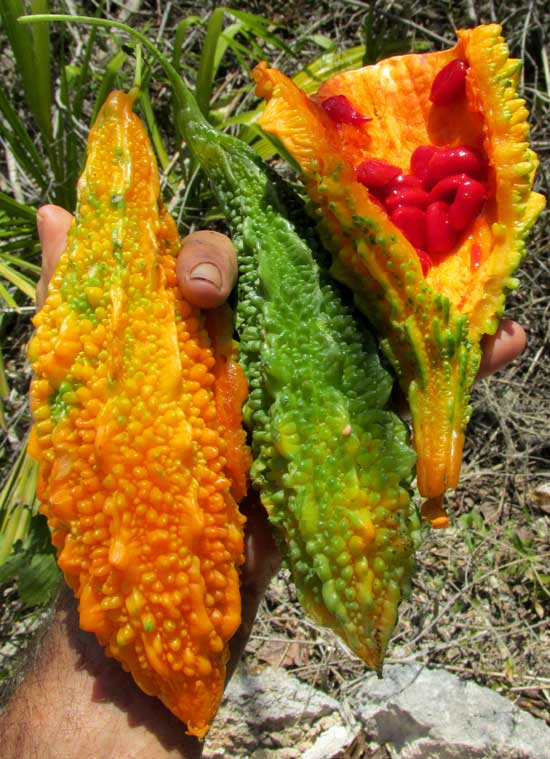
Though I'd never seen such large fruits of this kind, immediately I recognized what they were, because a certain weedy, introduced vine often is seen around here tangled in fences and growing at the disturbed edges of woods, and it produces fruits and seeds just like this, except much, much smaller -- usually only around two inches long (5cm). A member of the Cucumber/Melon/Gourd/Pumpkin Family, the Cucurbitaceae, it's Momordica charantia, often called Balsam-Pear, though the Bangladeshi friend who introduced a closely related species to me many years ago as an important ingredient in curries and other Southeast-Asian dishes called it Bitter Gourd. Originally the plant is from India. You can see the wild Balsam-pear vine growing wild and bearing split-open, mature fruits, along a street in Río Lagartos on the Yucatan's northern coast, at www.backyardnature.net/yucatan/momordic.htm
Don Solís grows one of many Balsam Apple cultivars. The cultivars differ considerably from one another, especially in terms of the fruits' shapes, sizes and bitterness. Don Solís sells Balsam Apple fruits commercially, apparently to buyers outside the Yucatan, because here few people know about it. The fruits he brought us had grown too large and bitter for human consumption, but the livestock ate them with relish. I read that in India Balsam Apple often is served with yogurt on the side to offset its bitterness. Also it's used in curry dishes, is stir-fried, is deep fried with peanuts, stuffed with spices and then cooked in oil... On and on the recipes go, which is a little surprising since even the smaller fruits normally are a little bitter. Some cultures are simply OK with a little bitterness, similar to how Mexicans spicy-hot dishes many people can't endure.
Often bitter plants are used medicinally, and that's the case here, Balsam Apple having been used in traditional medicine for centuries to treat ailments ranging from diabetes to ulcers, constipation, breathing problems and skin diseases. In fact, a 2014 study showed that Balsam Apple eaten raw or in juice form does indeed lower blood glucose levels.
The seeds' red, slimy coverings are "arils." Arils are different from seedcoats since arils arise from the seed's hilum or funiculus, not from the seed's covering. The funiculus is the seed's umbilical-cord-like attachment to the fruit's interior wall, and the hilum is the scar marking the seed's point of attachment to whatever it's attached to. When you see seeds with scarlet arils contrasting shockingly with a fruit's background color you can assume that the redness attracts birds and other critters who eat them, then disseminate the seeds in their poop.
The day after receiving the fruits I planted some of the fresh, still moist seeds. They germinated nicely, producing the robust seedlings shown below:
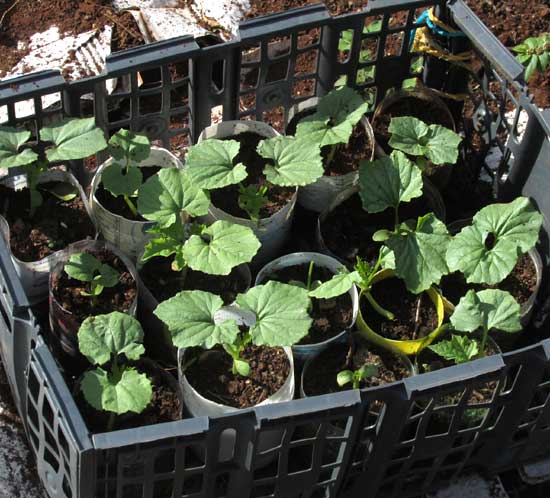
from the August 27, 2017 Newsletter issued from Rancho Regenesis in the woods ±4kms west of Ek Balam Ruins; elevation ~40m (~130 ft), N20.876°, W88.170°; north-central Yucatán, MÉXICO
BALSAM APPLE/ BITTER MELON FRUITING
Seeds I planted fresh from the fruits germinated easily and produced vigorous seedlings. I planted several along a fence, and now the vines, overgrowing the fence and completely hiding it, are producing numerous fruits, one of which you can see below:
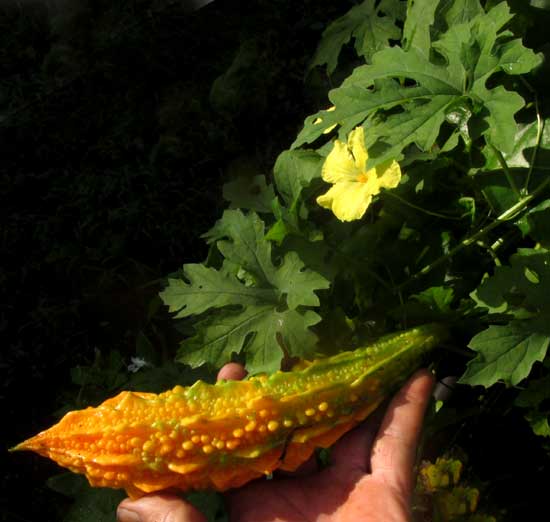
The flower in the picture is a male one. Below, a close-up of a male flower with one side removed shows healthy looking stamens with orangish, pollen-producing anthers:
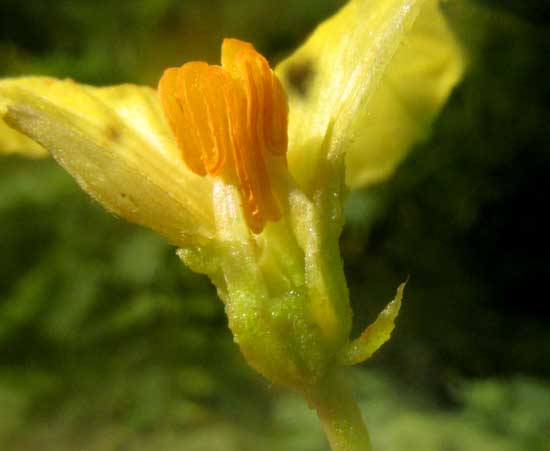
Members of the Cucumber/Melon/Gourd/Pumpkin Family, the Cucurbitaceae, to which Balsam Apple belongs, bear flowers with inferior ovaries, so the ovary would appear below the stamens and yellow corolla. In the above picture there's nothing beneath the corolla but a slender stem, the pedicel. Now, below, look at what's beneath a female flower's corolla:
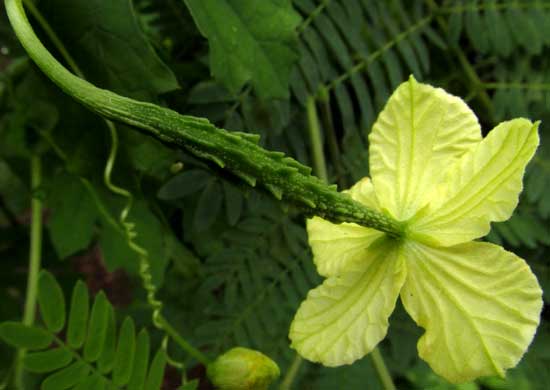
That spiny inferior ovary already is looking like a Balsam Apple fruit.
Thing is, even our small fruits are too bitter or at best tasteless to add to meals, so, the fruits just dangle there delighting visitors with their strange and colorful appearance, but soon splitting open, rodents and birds eat some, and then most just fall away. That makes room for more, for the vines are as prolific as they are underutilized.